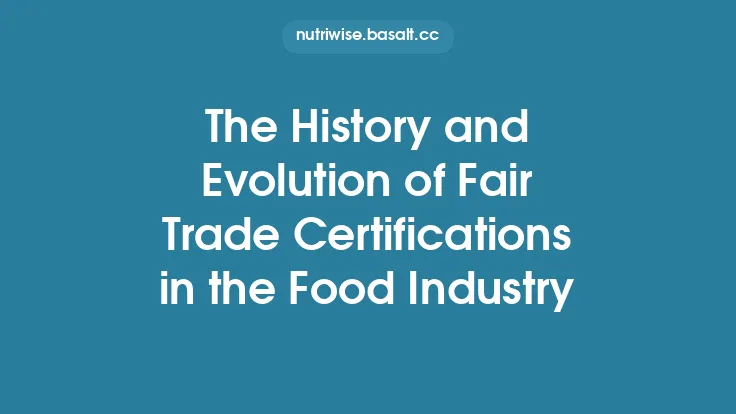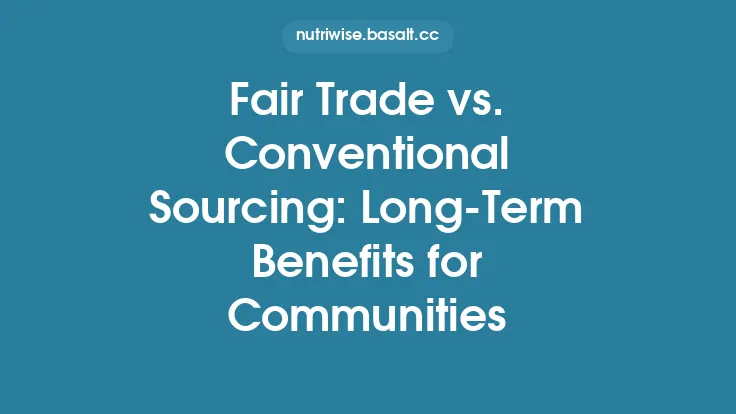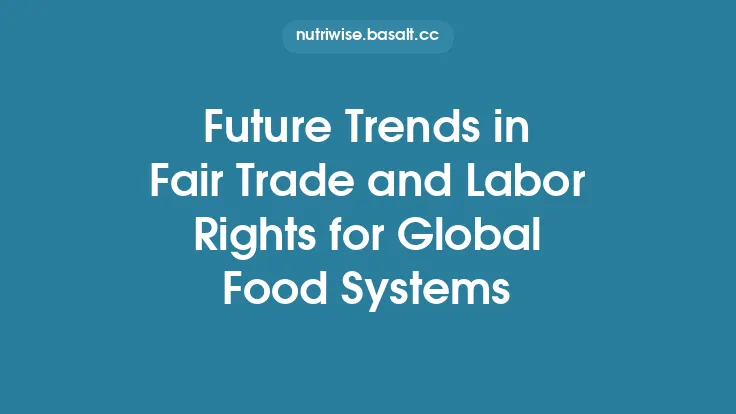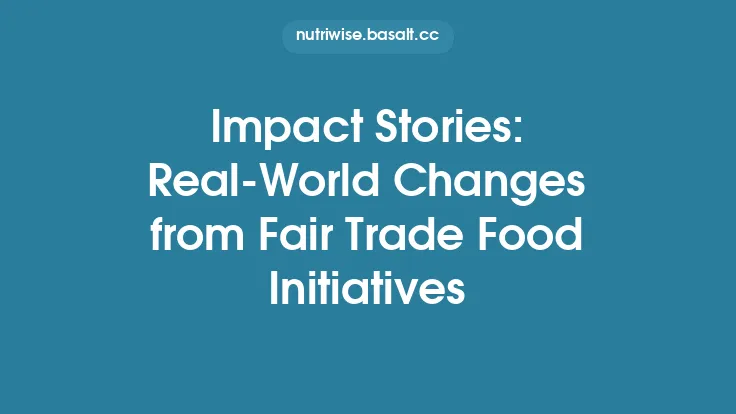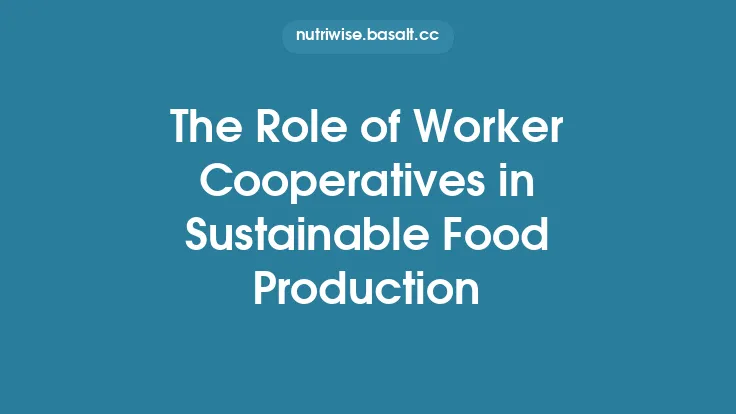Living‑wage guarantees sit at the heart of what makes fair‑trade food distinct from conventional sourcing. When a farmer or processor receives a wage that truly covers the cost of a decent standard of living—food, shelter, health care, education, and a modest amount for savings—the ripple effects extend far beyond the individual worker. Families become more resilient, communities can invest in better infrastructure, and the entire food system gains stability. This article unpacks how the living‑wage principle is defined, measured, enforced, and continuously refined within fair‑trade food practices, offering a deep dive into the mechanisms that keep wages fair, transparent, and sustainable.
Defining a Living Wage in Food Production
A living wage is not a static figure; it is a context‑specific benchmark that reflects the real cost of meeting basic human needs in a given region. In the fair‑trade framework, the definition incorporates:
| Component | Description |
|---|---|
| Basic Needs | Nutrition, safe housing, clean water, sanitation, and clothing. |
| Social Services | Access to primary health care, education for children, and a modest contribution to pension or retirement savings. |
| Family Allowance | An additional amount to support dependents, recognizing that many farm workers support extended families. |
| Inflation Buffer | A small percentage (typically 2‑5 %) added annually to preserve purchasing power. |
Fair‑trade standards require that the living‑wage calculation be regionally calibrated. This means that a coffee farmer in the highlands of Guatemala will have a different baseline than a wheat harvester in the plains of Ukraine, even though both operate under the same fair‑trade certification.
Translating Living‑Wage Requirements into Practice
Fair‑trade standards embed the living‑wage principle into three core contractual elements:
- Minimum Price Guarantee – A floor price that covers the cost of sustainable production plus a margin for a living wage. If market prices dip below this floor, the fair‑trade premium is used to bridge the gap.
- Fair‑Trade Premium – An additional sum (often 0.20 USD per kilogram of product) that is earmarked for community development, including wage‑related projects such as school fees or health clinics.
- Social‑Labor Clause – A binding clause that obligates producers to pay workers at least the locally determined living wage, with regular audits to verify compliance.
These contractual levers work together to ensure that the wage floor is not eroded by volatile commodity markets.
Economic Calculations Behind Living‑Wage Determinations
The living‑wage figure is derived through a bottom‑up costing model:
- Data Collection – Household surveys gather detailed expenditure data on food, housing, health, education, and transport.
- Cost of Living Index (CLI) – Survey results are aggregated into a regional CLI, expressed in local currency.
- Productivity Adjustment – The CLI is divided by the average labor productivity (e.g., kilograms of coffee per worker per day) to estimate the wage needed per unit of output.
- Margin for Risk – A risk premium (typically 10‑15 %) is added to account for seasonal fluctuations, crop failures, and market shocks.
- Annual Review – The calculation is revisited each year, incorporating inflation data and any changes in household consumption patterns.
This method ensures that the living wage is grounded in real economic conditions, rather than being an arbitrary figure.
Monitoring and Enforcement Mechanisms
Fair‑trade certification bodies employ a multi‑layered monitoring system:
- Annual Audits – Independent auditors visit farms and processing facilities, reviewing payroll records, bank statements, and worker contracts.
- Worker Interviews – Confidential interviews with a random sample of workers verify that wages reported on paper match actual receipts.
- Digital Traceability – Many fair‑trade supply chains now use blockchain or other distributed ledger technologies to record wage payments in real time, providing immutable proof of compliance.
- Grievance Procedures – Workers can lodge complaints through a designated hotline; investigations are launched within 48 hours, and corrective actions are mandated if violations are confirmed.
Non‑compliance can result in suspension of certification, loss of market access, and mandatory remediation plans.
The Role of Producer Organizations
While the focus here is on wages, it is worth noting that producer organizations (often cooperatives or farmer groups) act as the conduit for implementing living‑wage standards. They:
- Aggregate Data – Collect household expenditure data across members to refine the living‑wage calculation.
- Negotiate Premium Allocation – Decide how the fair‑trade premium will be used to support wage‑related community projects.
- Facilitate Training – Offer financial literacy and labor‑rights workshops, empowering workers to understand and claim their entitlements.
These organizations are essential for translating abstract standards into concrete, on‑the‑ground outcomes.
Impact on Workers’ Quality of Life
When living wages are reliably paid, measurable improvements emerge across several dimensions:
- Health – Access to regular medical check‑ups and better nutrition reduces incidence of work‑related illnesses.
- Education – Children of farm workers are more likely to complete primary school and pursue secondary education.
- Economic Resilience – Households can save for emergencies, invest in small‑scale enterprises, and reduce reliance on high‑interest informal loans.
- Gender Equality – Women, who often earn less than men in agricultural settings, benefit from standardized wage floors that close the gender pay gap.
Longitudinal studies in fair‑trade coffee regions have shown a 15‑20 % increase in household savings and a 10 % rise in school attendance after living‑wage implementation.
Challenges and Criticisms
Despite robust mechanisms, several hurdles persist:
- Data Accuracy – Household surveys can be affected by recall bias or under‑reporting of informal income.
- Seasonality – Agricultural work is often seasonal; ensuring a year‑round living wage may require supplementary off‑season employment or cash‑flow management.
- Market Pressures – In years of extreme price drops, the premium may be insufficient to fully cover the living‑wage gap, leading to temporary shortfalls.
- Compliance Costs – Smallholder producers sometimes struggle with the administrative burden of audits and record‑keeping.
Addressing these issues requires continuous refinement of methodologies and collaborative problem‑solving among certifiers, producers, and buyers.
Strategies for Continuous Improvement
To keep living‑wage standards effective and adaptable, the fair‑trade system employs several forward‑looking strategies:
- Dynamic Benchmarking – Incorporating real‑time price data and inflation indices to adjust wage floors more responsively.
- Capacity‑Building Grants – Providing micro‑grants to smallholders for accounting software and training, reducing compliance barriers.
- Multi‑Stakeholder Platforms – Regular forums where workers, NGOs, buyers, and certifiers co‑design improvements to wage calculations.
- Impact‑Linked Premiums – Linking a portion of the fair‑trade premium to verified wage outcomes, incentivizing producers to exceed baseline requirements.
These approaches aim to make the living‑wage principle not just a static rule, but a living component of the fair‑trade ecosystem.
Consumer Implications
For the everyday shopper, the living‑wage principle translates into a transparent value proposition:
- Price Premiums – Products bearing the fair‑trade label may cost slightly more, reflecting the higher labor cost.
- Traceability Assurance – Knowing that a portion of the purchase price directly funds a living wage gives confidence that the money is supporting real people.
- Ethical Alignment – Consumers who prioritize social justice can align their purchasing habits with a concrete, measurable impact.
By choosing fair‑trade certified foods, shoppers help sustain the wage floor that underpins ethical food production.
Looking Ahead
Ensuring living wages is an ongoing commitment that requires rigorous data, vigilant monitoring, and collaborative problem‑solving. As global supply chains become more complex, the fair‑trade framework continues to evolve, refining its wage calculations and enforcement tools to keep pace with changing economic realities. The ultimate goal remains clear: a food system where every worker receives a wage that truly supports a dignified, healthy, and hopeful life.
